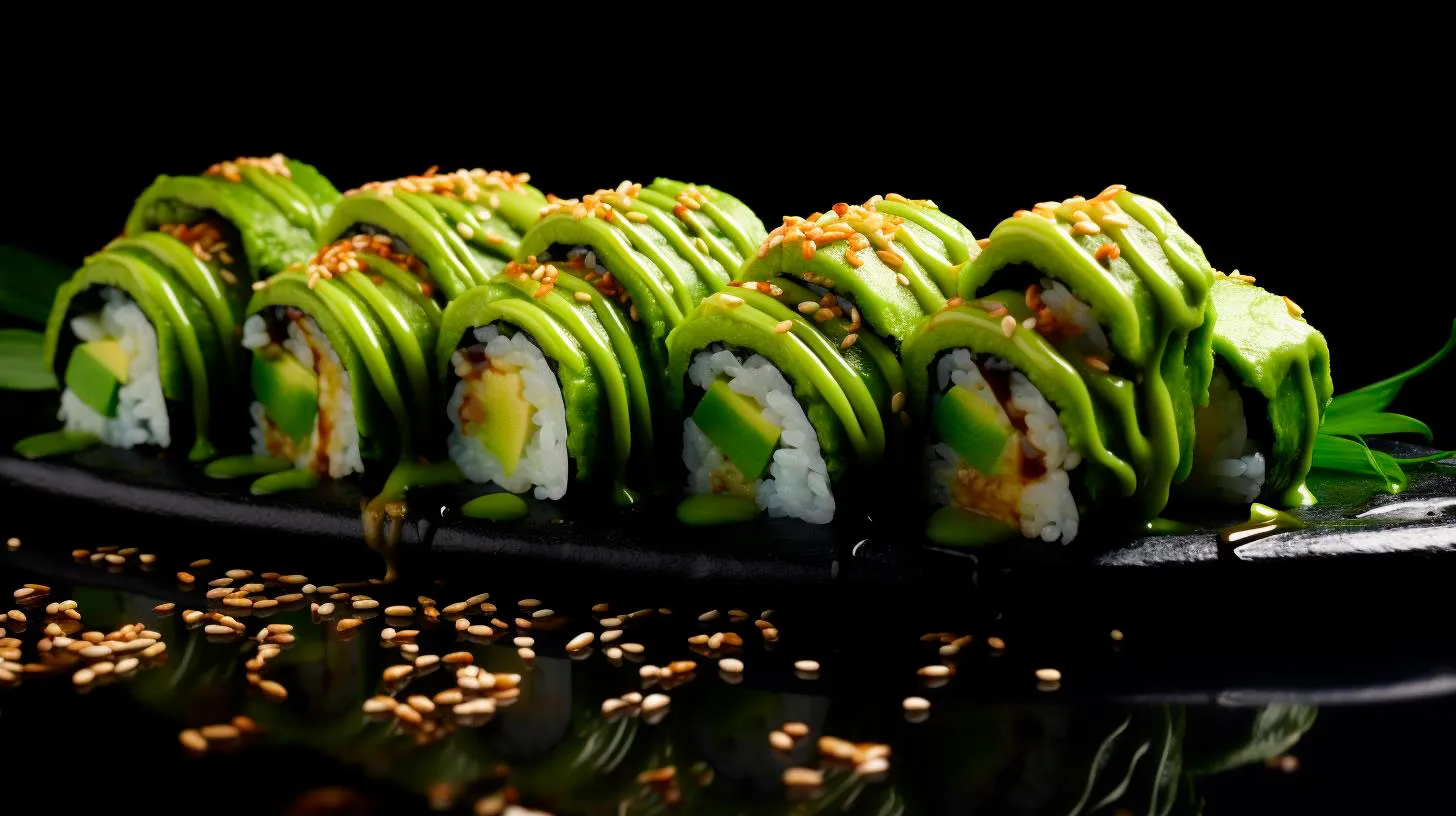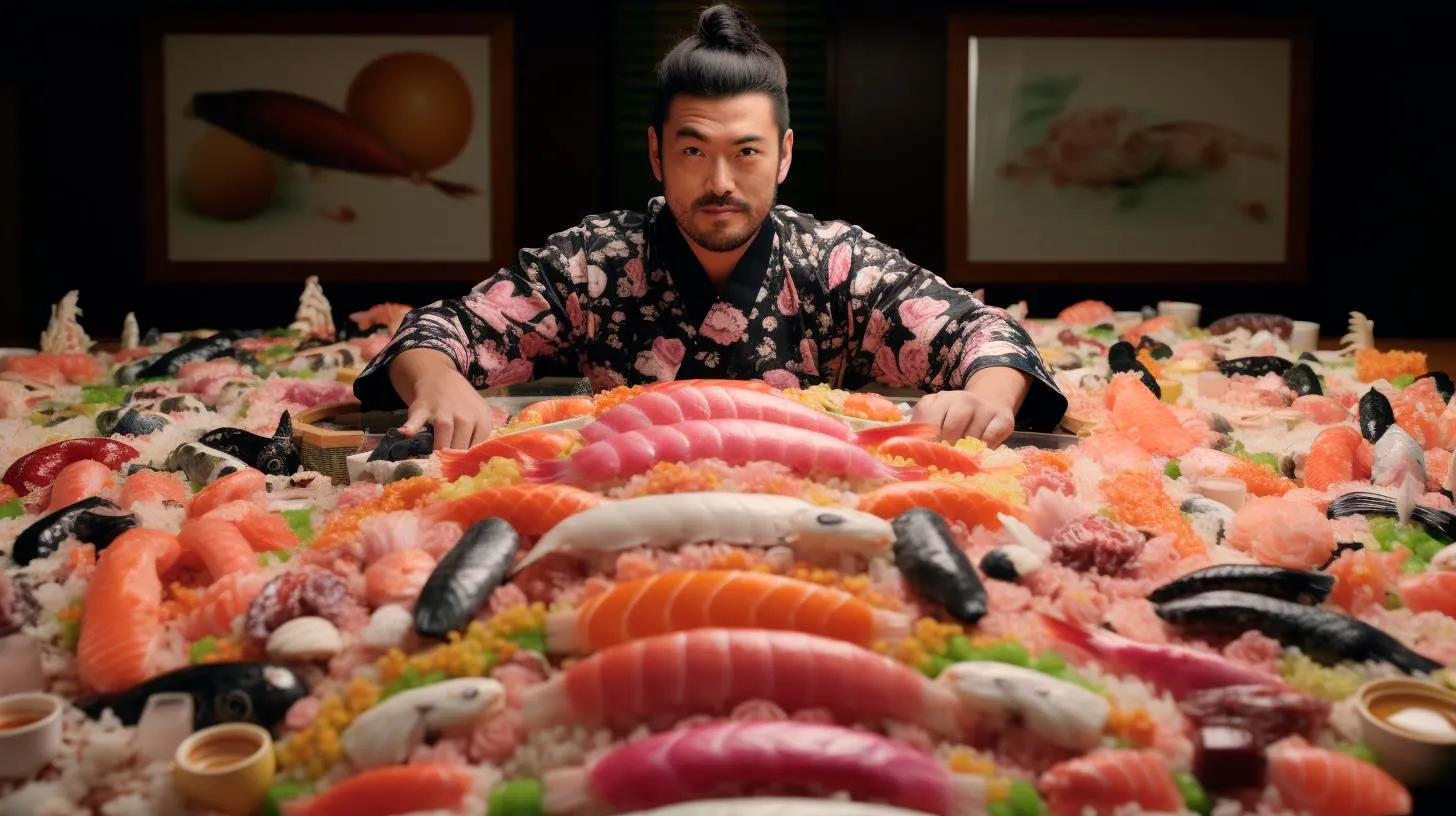The Origins and Distinctions of Tobiko and Masago Explained
Origins of Tobiko and Masago
Tobiko and masago are both types of fish roe commonly used in Japanese cuisine, but they differ in terms of the fish species they come from and the regions they originate from. Let’s take a closer look at their origins:
- Tobiko: Tobiko refers to the roe of flying fish, primarily sourced from the waters of the Pacific Ocean. It is a delicacy in Japan and often used to enhance the visual appeal and taste of sushi and sashimi dishes.
- Masago: Masago, on the other hand, refers to the roe of capelin, a small fish found in the North Atlantic and Arctic oceans. It is widely used in Japanese and other Asian cuisines, adding a pop of color and subtle briny flavor to various dishes.
Distinctive Characteristics
While tobiko and masago share similarities in terms of being fish roe, there are distinct characteristics that set them apart. Understanding these differences can help you make informed choices when using them in your recipes:
Tobiko:
- Tobiko eggs are comparatively larger in size, ranging from 0.5 to 0.8mm, and have a vibrant range of colors, including orange, red, green, and black.
- It offers a satisfying crunch when eaten, adding an interesting texture to sushi rolls or sashimi presentations.
- The flavor of tobiko is often described as nutty and slightly sweet, with a hint of brininess.
- Popular variations of tobiko include wasabi-infused tobiko, which adds a spicy kick to dishes, and yuzu tobiko, which has a citrusy tang.
- Tobiko is commonly used as a garnish, adding visual appeal to sushi, salads, and various seafood preparations.
Masago:
- Compared to tobiko, masago eggs are smaller in size, ranging from 0.5 to 0.7mm, and are typically bright orange in color.
- It has a softer texture, subtly bursting with a slight pop when consumed.
- The flavor of masago is delicately mild and slightly salty, making it a versatile ingredient in a variety of dishes.
- Black masago, known as kazunoko, is a popular option with a stronger taste, frequently enjoyed during Japanese New Year celebrations.
- Masago is commonly used in sushi rolls, rice bowls, and as a topping for various Japanese street foods.
The Versatility and Advantages of Tobiko and Masago
Both tobiko and masago bring unique qualities to culinary creations, offering chefs and food enthusiasts several advantages:
- Enhanced Flavor: Tobiko and masago elevate the flavors of dishes, adding a delightful burst of umami and brininess.
- Textural Delight: The caviar-like texture of tobiko and masago adds a pleasing crunch or pop to every bite, creating an enjoyable dining experience.
- Visual Appeal: The vibrant colors of tobiko and masago make them excellent additions for enhancing the visual appeal of various dishes, making them visually enticing.
- Ingredient Versatility: Both tobiko and masago can be used in various sushi rolls, nigiri, rice bowls, and even as a topping for salads or appetizers, providing endless creative possibilities.
According to a survey conducted by the Japan External Trade Organization (JETRO), the global consumption of sushi and sashimi has been steadily growing, with a 7% increase in the past five years. As a result, the demand for premium sushi ingredients like tobiko and masago is on the rise.
Key Takeaways
Tobiko and masago are popular fish roes used in Japanese cuisine, each offering its unique characteristics and flavors:
- Tobiko, sourced from flying fish, has larger eggs, vibrant colors, a nutty taste, and is commonly used as a garnish.
- Masago, sourced from capelin, has smaller eggs, a slightly salty taste, and is widely used in sushi rolls and rice bowls.
The versatility, flavors, and visual appeal of tobiko and masago make them valuable additions to your culinary repertoire. Whether you’re a sushi aficionado or an adventurous foodie, experimenting with these delicate fish roes will surely elevate your dining experience to new heights!
Health Benefits Unveiled: Nutritional Value of Tobiko and Masago
So, let’s dive in and discover what makes Tobiko and Masago so nutritious.
1. Packed with Essential Nutrients
Tobiko and Masago, both being fish roe, are incredibly rich in essential nutrients that contribute to overall well-being. They are excellent sources of protein, providing all nine essential amino acids required by the body. This makes them a valuable option for those following a vegetarian or pescatarian diet.
These delicacies are also abundant in vitamins and minerals. Tobiko delivers significant amounts of vitamin A, important for healthy vision, as well as vitamins B12, D, and E. Masago, on the other hand, provides a substantial dose of vitamin C, which is known for its immune-boosting properties, along with calcium, iron, and selenium.
Key Takeaway:
- Tobiko and Masago are rich in protein, making them suitable for vegetarian and pescatarian diets.
- Tobiko is high in vitamin A, B12, D, and E, while Masago contains vitamin C, calcium, iron, and selenium.
2. Omega-3 Fatty Acids for Heart Health
Omega-3 fatty acids are highly beneficial for heart health, reducing the risk of cardiovascular diseases. Both Tobiko and Masago are fantastic sources of these essential fats. Omega-3s help reduce inflammation, lower triglycerides, and maintain a healthy heartbeat and blood pressure.
Research suggests that regularly consuming omega-3 rich foods may decrease the likelihood of heart attacks, strokes, and arrhythmias. Including Tobiko or Masago in your diet can help you achieve the optimal intake of these heart-healthy fatty acids.
Key Takeaway:
- Tobiko and Masago are excellent sources of heart-healthy omega-3 fatty acids.
- Omega-3s help reduce inflammation, lower triglyceride levels, and maintain cardiovascular health.
3. Antioxidant Powerhouses
Antioxidants play a crucial role in neutralizing harmful free radicals in the body, which can cause cellular damage and lead to chronic diseases. Tobiko and Masago are abundant in antioxidants, particularly vitamin E and selenium.
These antioxidants protect the cells from oxidative stress and support the immune system. Vitamin E, found in Tobiko, has been linked to reduced risks of age-related macular degeneration and certain types of cancer. Selenium, present in Masago, helps to stimulate the immune response and regulate thyroid function.
Key Takeaway:
- Tobiko and Masago are packed with antioxidants that fight against cell damage and boost the immune system.
- Vitamin E in Tobiko may reduce the risk of age-related macular degeneration and certain cancers.
- Selenium in Masago supports the immune response and thyroid function.
4. Low in Calories, High in Flavor
If you are looking to indulge your taste buds without piling on excess calories, Tobiko and Masago are ideal choices. These fish roe are low in calories while providing abundant flavor to any dish they accompany.
With approximately 40 calories per tablespoon, Tobiko and Masago can elevate the taste of your sushi rolls, salads, or pasta dishes without compromising your calorie intake. This makes them a delicious and figure-friendly option for those who are mindful of their weight.
Key Takeaway:
- Tobiko and Masago add flavor to dishes without adding excessive calories.
- Enjoying these fish roe can enhance your culinary experiences while being mindful of your calorie intake.
In conclusion, Tobiko and Masago not only satisfy your palate but also offer a wide range of health benefits. They are packed with essential nutrients, including proteins, vitamins, and minerals. Additionally, they are rich in heart-healthy omega-3 fatty acids and antioxidants. Lastly, these delicacies provide flavorful experiences without guilt-inducing calorie loads.
Next time you savor Tobiko or Masago, remember the remarkable nutritional value they bring to your plate. Stay tuned for more informative articles here at our tech blog!
Elevate Your Sushi Experience: Creative Uses for Tobiko and Masago
Tobiko and masago, two types of fish roe, are perfect examples of these unique and flavorful additions that can enhance your sushi dishes in exciting and unexpected ways.
What is Tobiko?
Tobiko is the roe of flying fish, usually sourced from Japan. This vibrant ingredient adds an eye-catching pop of color to any sushi roll or dish. With its small size and crunchy texture, tobiko provides a burst of briny flavor that complements the other ingredients perfectly. It comes in a variety of colors, including orange, red, black, and even green (made with wasabi).
Some key features and advantages of tobiko include:
- Elevates the visual appeal of sushi dishes with its bright colors
- Delivers a satisfying crunch with each bite
- Enhances the overall taste and complexity of the dish with its briny flavor
- Provides a rich source of essential nutrients like Omega-3 fatty acids and vitamins
Creative Uses for Tobiko
Aside from traditional uses, such as topping nigiri or adding a colorful touch to a California roll, tobiko can be used in many creative ways to elevate your sushi experience. Here are some ideas for incorporating tobiko into your next sushi creation:
- Tobiko Mayo: Combine tobiko with mayonnaise to create a flavorful and visually appealing sauce. This can be used as a dip or as a topping for various sushi rolls and bowls.
- Tobiko Sushi Bombs: Roll seasoned sushi rice into bite-sized balls and coat them with tobiko. These bite-sized treats will impress your guests and add a burst of flavor with every bite.
- Tobiko Maki: Instead of simply using tobiko as a topping, roll it inside the sushi roll to add both texture and taste to your favorite roll.
- Tobiko Garnish: Sprinkle tobiko on top of sashimi or sushi rolls for an elegant finishing touch. Its vibrant colors will make your dish visually stunning.
What is Masago?
Masago, like tobiko, is another type of fish roe commonly used in sushi. It is typically sourced from the capelin fish and has a smaller size compared to tobiko. Masago has a distinct mild flavor that enhances the overall taste profile of sushi dishes. It is commonly seen as orange or red in color.
Here are some key takeaways and advantages of masago:
- Delicate texture that adds a subtle pop to every bite
- Brings a mildly sweet and savory taste to sushi rolls
- Rich in protein and essential minerals like selenium and magnesium
- Antioxidant properties that contribute to a healthy diet
Creative Uses for Masago
Move beyond the basic uses of masago and explore its incredible potential to enhance your sushi experience. Consider these creative ideas:
- Masago Sushi Salad: Mix masago with fresh vegetables, avocado, and a tangy dressing to create a refreshing and nutritious sushi-inspired salad.
- Masago Omelette: Incorporate masago into your omelette batter for a burst of flavor and visually appealing specks of color.
- Masago Sushi Pizza: Create a sushi-inspired pizza by adding masago on top of a crispy rice crust along with other favorite toppings. Bake until golden and enjoy a unique fusion of flavors.
- Masago Dip: Combine masago with cream cheese, sour cream, and herbs to make a delightful dip. Serve it alongside sushi rolls or as a delicious appetizer.
Conclusion
Exploring the versatile uses of tobiko and masago allows you to introduce exciting flavors, vibrant colors, and unique textures into your sushi creations. These fish roe options not only add visual appeal but also contribute to the overall taste and nutritional value of your dishes. Whether you choose to use tobiko’s crunchy burst or masago’s mild subtlety, elevating your sushi experience with these fish roe varieties is guaranteed to leave a lasting impression on your taste buds.
Tobiko vs Masago: Which Fish Roe Reigns Supreme in Sushi?
In this article, we’ll explore the characteristics, advantages, and key takeaways of each, helping you make an informed choice the next time you indulge in sushi.
The Battle of the Sushi Fish Roe: Tobiko and Masago
Both Tobiko and Masago are fish roe commonly found in sushi dishes. However, there are notable differences between the two that set them apart. Let’s get a closer look at each:
Tobiko: The Jewel of the Sea
Tobiko, derived from the Japanese word “tobi,” meaning “to fly,” is the seasoned roe of the flying fish. This particular roe varies in color, including vibrant orange, red, yellow, green, or black. Tobiko eggs are small, crunchy, and known for their distinct flavor. Here are some noteworthy features and advantages of Tobiko:
- Tobiko is known for its bold flavors, with a hint of saltiness, making it a favorite among sushi enthusiasts.
- The appealing texture of Tobiko adds a delightful crunch to sushi rolls and other dishes.
- Tobiko has a longer shelf life compared to other types of fish roe, ensuring freshness and quality.
- With its various colors, Tobiko allows chefs to create visually stunning presentations, making it a popular choice for sushi rolls.
- Rich in omega-3 fatty acids, Tobiko also offers nutritional benefits that support heart health and brain function.
Masago: The Delicate Delight
Masago, on the other hand, is the roe of the small capelin fish. It is often compared to Tobiko due to its small size and similar texture. While Tobiko is known for its vibrant appearance, Masago is typically orange in color. Let’s take a look at the features and advantages of Masago:
- With its delicate and subtle flavor, Masago complements the taste of sushi without overpowering it.
- The small and round eggs of Masago provide a pleasant pop when bitten into, adding an enjoyable textural element.
- Since Masago eggs are smaller than Tobiko, they blend seamlessly with other ingredients in sushi rolls.
- Along with its aesthetic appeal, Masago delivers a nutritional punch, offering high protein content and essential vitamins.
- Due to its milder taste, Masago appeals to both sushi connoisseurs and those who are new to fish roe.
Key Takeaways: Tobiko vs Masago
When it comes to choosing between Tobiko and Masago, it ultimately depends on personal preferences and the overall flavor profile you desire in your sushi. Here are the key takeaways to help you make an informed decision:
- Tobiko is bolder in flavor and texture, adding a crunchy sensation and vibrant colors to your sushi rolls.
- Masago offers a gentler flavor and a delicate pop, seamlessly blending with other ingredients in your sushi.
- Both Tobiko and Masago provide nutritional benefits, with omega-3 fatty acids in Tobiko and high protein content in Masago.
- The choice between Tobiko and Masago can also depend on the overall presentation and aesthetic appeal you desire for your sushi.
- Experimenting with different types of fish roe can enhance your sushi experience, allowing you to discover new flavors.
So, whether you prefer the bold and crunchy Tobiko or the delicate and subtle Masago, both fish roe options add an extra layer of delight to your sushi rolls. So next time you order sushi, don’t forget to savor the unique experience each brings to the table!


